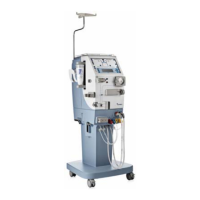How the measuring process is performed by
the machine
It is possible to measure clearance during treatment by
using a conductivity sensor placed after the dialyzer in
the fluid path.
A measurement check is performed in two phases.
During the first measurement phase (baseline phase) data
from the sensor is collected for some minutes.
The second phase (step phase) begins with an increase
or a decrease in the conductivity level. This is followed
by data collection for some minutes. If there will be an
increase or a decrease is dependent on the relation of the
conductivity levels in the dialysis fluid before and after
the dialyzer in the first phase. This is to ensure that the
patient’s sodium balance remains as neutral as possible.
When the second phase is complete the conductivity level
is returned to the set value and the clearance calculation
is performed. The calculation is based on the measured
difference between the conductivity levels in the first and
second phases.
Glossary of Diascan
®
parameters and key
terms
Parameters:
K is clearance. Clearance tells the operator how much
blood, in ml/min, is cleaned of urea after it has passed the
dialyzer. This value can be compared with the current
blood flow rate at that time.
1
2:4
AK 96
®
Operator's Manual - Diascan
HCEN12239 Revision 12.2010
Program version 3.xx

